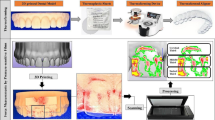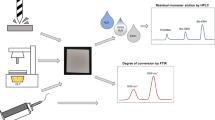Abstract
Background
Clinically, in dental practice the durability of zirconia adhesion is the key to successful long-term all-ceramic structures, e.g. fixed partial dentures (FPDs).
Purpose
To evaluate the effects of seven different surface conditioning methods on the shear bond strength of particulate filler resin composite cement bonded onto a zirconia surface.
Methods
Seven groups of zirconia each consisting of 14 specimens (n = 14) were made. The specimens were conditioned using various methods and embedded into acrylic cylinders with an acrylic polymer material to form substrates. The specimens were cleaned in an ultrasonic device for 300 s. Self-adhesive particulate filler resin composite stubs were added onto zirconia surfaces and photopolymerized for 40 s. The specimens were kept in distilled water for 24 h at room temperature and thermocycled 6,000 cycles (5 ± 1°C-55 ± 1°C). The shear bond strengths were measured with a crosshead speed of 1.0 mm/min and the data were analyzed by ANOVA.
Results
The shear bond strengths varied widely and ANOVA revealed significant differences between the groups (p < 0.001).
Conclusions
Tribochemical silicatization combined with silanization achieved the highest shear bond strength values.
Similar content being viewed by others
References
Denry I, Kelly JR (2008) State of the art of zirconia for dental applications. Dent Mater 24:299–307
Matinlinna JP, Heikkinen TT, Özcan M, Lassila LVJ, Vallittu PK (2006) Evaluation of resin adhesion to zirconia ceramic using some organosilanes. Dent Mater 22:824–831
Aboushelib MN, Matinlinna JP, Salameh Z, Ounsi H (2008) Innovations in bonding to zirconia-based materials: Part I. Dent Mater 24:1268–1272
Gun’ko VM, Voronin EF, Mironyuk IF, Leboda R, Skubiszewska-Zie J, Pakhlov EM, Guzenko NV, Chuiko AA (2003) The effect of heat, adsorption and mechanochemical treatments on stuck structure and adsorption properties of fumed silicas. Colloid Surface A 218:125–135
Satoh A (1999) Water glass bonding. Sensor Actuator A 72:160–168
Darvell BW (2000) Material science for dentistry, 6th edn. Darvell, Hong Kong, pp 394–396
Guess PC, Kulis A, Witkowski S, Wolkewitz M, Zhang Y, Strub JR (2008) Shear bond strengths between different zirconia cores and veneering ceramics and their susceptibility to thermocycling. Dent Mater 24:1556–1567
Author information
Authors and Affiliations
Corresponding author
Rights and permissions
About this article
Cite this article
Heikkinen, T.T., Matinlinna, J.P., Vallittu, P.K. et al. Dental Zirconia Adhesion with Silicon Compounds Using Some Experimental and Conventional Surface Conditioning Methods. Silicon 1, 199–202 (2009). https://doi.org/10.1007/s12633-009-9022-2
Received:
Accepted:
Published:
Issue Date:
DOI: https://doi.org/10.1007/s12633-009-9022-2




